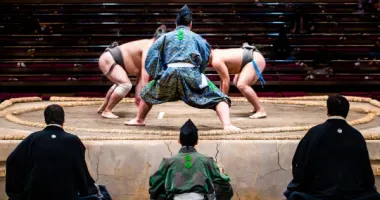Nippara Limestone Cave
Nippara Limestone Cave is one of the biggest limestone caves in the Kanto area. It is open to the public and there is a bus from Okutama Station.
- Into the Okutama Mountains
- Nippara Limestone Cave
- Cultural Heritage Tours
- Nippara Limestone Cave
- Wasabi Farm Tour
- Tama Area Access
by Johannes Schonherr
Nippara Limestone Cave, Okutama, Tokyo 日原鍾乳洞 奥多摩 東京
 Nippara Limestone Cave, Okutama, Tokyo
Nippara Limestone Cave, Okutama, Tokyo
This is part 1 of a two-part text covering the Voyagin Nippara Limestone Cave / Wasabi Farm Tour through Voyagin.
Travel tour company Voyagin has recently been very active in organizing regularly offered outdoor activities led by English-speaking guides / instructors in the Tama Region of western Tokyo.
Though within easy reach from Shinjuku by train, the Tama Region is very different from the 23 wards making up the urban center of Tokyo.
Still densely populated in its eastern parts, around the cities of Kokubunji, Fuchu and Tachikawa, the further out west you get, the more rural and mountainous the landscape gets.

New road safety construction, abandoned river fishing facility and needle-like rock, Ogawa Valley, Okutama, Tokyo
The western-most town of Tokyo-to, the administrative structure encompassing all of Tokyo, is Okutama. Its name translates as "Inner Tama".
It covers a large territory but it is very thinly populated. You are worlds away there from the busy streets of Shinjuku and Shibuya though the train trip doesn't take much more than 90 minutes.
It is in the hinterlands of this wild mountainous area where most of the Voyagin activities take place.
Those activities fall into two main categories: on the one hand adventure, outdoor activities such as white water rafting, river kayaking, mountain biking tours and the like.
At the same time Voyagin also offers tours exploring the rich cultural heritage of the area. For example, you can take part in an indigo dyeing workshop, you can receive a day of training in ninja martial arts and ninja spiritual philosophy.
You can also explore the Nippara Limestone Cave located in the furthest north-west of Okutama via a Voyagin tour and visit a wasabi farm including a tasting of freshly harvested wasabi.
Those two latter tours are guided by David Hulme, an Australian living in the mountains of Okutama.
You can take them either as a full one-day tour, first visiting the Nippara Limestone Cave and then witnessing how wasabi is actually grown in a wasabi patch farmed by David himself.
Another option would be to just go on an afternoon trip to David's wasabi farm. Both versions can be booked via the Voyagin website.
I was recently invited by Voyagin to explore a couple of their Tama tours on offer and chose the combined Nippara Limestone Cave & Wasabi Farm Tour.

Road in the Ogawa Valley, Okutama, Tokyo Rocks in the Ogawa Valley, Okutama, Tokyo
Rocks in the Ogawa Valley, Okutama, Tokyo
Into the Okutama Mountains
I arrived at Okutama Station a bit earlier than the set 10 am meeting time of the tour group with our guide David. Okutama Station is very small. It has only one exit with a local tourist information office right at the station square. Buses for Okutama Lake as well as to the tiny settlements deeper in the mountains wait at the little bus center across the street.
Soon enough, a foreigner with a white beard eyed me and asked, "Are you Johannes?" I answered in the affirmative and he introduced himself as David, the tour guide.
It turned out that I was the only guest on the tour that day. Lucky me. A clear blue sky above, the autumn color season just starting and I got a guide all to myself.
We quickly jumped into David's minibus. Besides the driver, it can carry three passengers. David told me that if four or more people would sign up for the tour, he would travel with them by public bus.
Being only the two of us this time, we drove out of Hikawa in David's minibus. Hikawa is the tiny town around Okutama Station.
Formerly known as Hikawa Village, Hikawa is now, thanks to the JR train line from Tokyo terminating there, the center of Okutama Town.
Okutama stretches far, far out from there. While the roads became narrower and narrower and more winding as we went deeper into the mountains, David told me that he used to be an international journalist, covering Asian economics but that he eventually found his real home out here in the mountains. In an area that feels about a thousand miles away from the Foreign Correspondents' Club Japan in Yurakucho, central Tokyo.
We parked the car at the lot of the Nippara Limestone Cave. However, a steep rock wall further up the road had drawn my attention. I asked David if we could have a closer look. He happily agreed.
Signs pointed out that we had entered the Ogawa Valley here. Road construction had recently been done though there was no indication where that road might eventually lead to. We walked by an impressive needle-like rock, an abandoned river-fishing outlet, and explored ancient Buddhist sculptures placed in the holes washed out of a limestone rock wall.
We were quite a bit off the original tour plan at this point. David didn't mind - I was the only one on his tour that day and whatever I was interested in, he was open to explore with me.
By now we walked an unpaved forest road. David kept telling me about the various plants on the side of the road. In ancient times, people found uses for almost every plant growing. For their leaves, for their fruits, for their stems.
He pointed one out. At first glance it was a rather unremarkable plant but he explained that the stems of that particular plant made for the most perfect arrows.
In fact, he said, that plant, the yomogi or Japanese mugwort has multiple uses. Its leaves provide the fresh fragrance and green color to Kucha Mochi, a Japanese confectionery, they can also be brewed to make a healthy herb tea.
As pleasurable it was to walk the old forest road along a small winding river, looking at the autumn colors and the rock formations above, it was eventually time to turn back.
I had come for a tour of the Nippara Limestone Cave after all.

Entrance to the Nippara Limestone Cave, Okutama, Tokyo Inside the Nippara Limestone Cave, Okutama, Tokyo
Inside the Nippara Limestone Cave, Okutama, Tokyo
Nippara Limestone Cave
The Nippara Limestone Cave (nippara.com) is one of the biggest limestone caves in the Kanto area. It is open to the public and there is a bus connecting it with Okutama Station a few times a day.
You need to buy a ticket getting in (even when on a Voyagin tour), once you enter the cave you need to be careful not hit your head on the rocks above. Especially the area right behind the entrance is narrow, the ceiling very low. You will have to climb many stairs inside the cave. Water is constantly dripping from above with the temperature about 11°C throughout the year. Make sure to wear a good jacket and waterproof boots.
After the initial narrow section, the cave soon widens. It is lit up partly by very colorful lights. Underground water flows washed this cave out of the soft limestone millions of years ago, leaving a bizarre underground landscape of both large halls and narrow channels.

Underground River, Nippara Limestone Cave, Okutama, Tokyo Nippara Limestone Cave, Okutama, Tokyo
Nippara Limestone Cave, Okutama, Tokyo
In medieval times, Yamabushi mountain monks took over the cave. They lived in it, they used it for meditation and spiritual rituals and they gave names to various strangely shaped underground rocks - names based in Buddhist scripture.
Because those ancient monks were keen at keeping records, those names still survive today. You will see many signs pointing them out both in kanji and hiragana. None of them are labeled in English, though.
That is were David comes in. He can tell you fascinating stories about the background of many of those names.
In more recent times, cave researchers discovered an offshoot of the cave that even the ancient monks seem not be have been aware of. This part is now open to the public as well. There, the stalactites grow in even more bizarre fashions than in the main, traditional part of the cave.

Stone carving of Enmusubi, Goddess of Tight Relations, Nippara Limestone Cave, Okutama, Tokyo
Vegetable gardens at Tamagaku-en
The bright autumn sun blinded our eyes once we got out of the cave. By now, it was lunch time.
David suggested a restaurant and so we drove there. The restaurant belongs to the Tamagaku-en (www.tama-gaku.com), he told me, a facility for mentally handicapped people in which he works part-time.
We strolled through the Tamagaku-en farm. A large amount of Shiitake mushrooms is grown here. These mushrooms grow on dead wood - the logs feeding the mushrooms covered a large slope.
There were also various vegetable gardens, and a few greenhouses. In one of those greenhouses David nurtures his wasabi seedlings. He was very happy to see how well they had progressed.
The Saka Restaurant (www.tama-gaku.com) is part of the Tamagaku-en facility as well. That is where we had our lunch. The Saka offers a daily changing lunch menu of Japanese / Western fusion food. Sandwiches and hamburgers accompanied by artfully created and decidedly Japanese appetizers. Still, the lunch comes only to about 900 yen. (The Saka operates only at lunch time, last order is at 2.30 pm)
 Shiitake mushroom farm at Tamagaku-en, Okutama, Tokyo
Shiitake mushroom farm at Tamagaku-en, Okutama, Tokyo Tour guide David waters his wasabi seedlings, Tamagaku-en, Okutama, Tokyo
Tour guide David waters his wasabi seedlings, Tamagaku-en, Okutama, Tokyo
Wasabi Farm Tour
After a very satisfying lunch, it was time to start the tour of David's wasabi farm. Read about it in part 2 of this story.
Access
Access to Ome and Okutama: Take the JR Chuo Line from Shinjuku Station to Tachikawa or Ome, change in Ome to the Ome Line. Okutama Station is the final stop out west on the Ome Line.





























